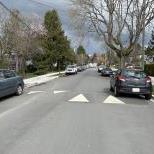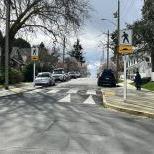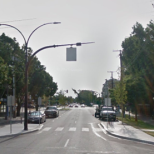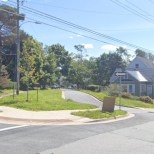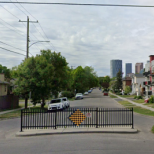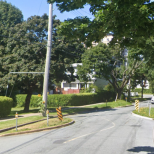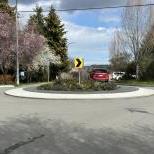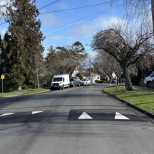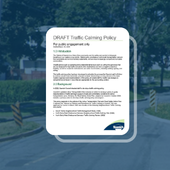Traffic Calming Policy
We want to hear from you!
Take the survey on HelloSaanich by May 31, 2025.

Introduction
The District of Saanich is creating a Traffic Calming Policy to articulate the process that Saanich staff will follow to address unsafe and undesirable vehicular conduct. Saanich is a Vision Zero community, which means we have an ambitious goal to eliminate traffic fatalities and serious injuries on Saanich roads, while ensuring safe, healthy, and equitable mobility for all people.
Background
The safety and comfort of all people travelling on our roads is a top priority. Vehicular speeding and cutting through areas that are not designed for high traffic can have a negative impact on livability, as well as the use of active travel modes, including walking, cycling, and rolling. Changes to road design can enable users to travel safely in the community and the traffic calming policy will allow for the appropriate and transparent prioritization of projects that retrofit streets to be safer.
Both the Active Transportation Plan and Road Safety Action Plan include actions for Saanich staff to develop a Traffic Calming Policy and Program, and it is a key step on the road to achieving Vision Zero. In recognition of this, Saanich Council has directed staff to develop a Traffic Calming Policy.

What is Traffic Calming?
Traffic calming refers to the range of approaches used to reinforce appropriate driver behaviour and support the creation of safer streets. Traffic calming is most commonly thought of as physical infrastructure designed to reduce vehicle speeds, reduce traffic volumes, and address traffic short-cutting. It may also include communications, enforcement and other non-infrastructure approaches.
What are some examples of Traffic Calming
Goals
The goals of this policy are to:
- Improve livability in neighbourhoods
- Increase active transportation
- Improve safety and the perception of safety for people travelling by all modes
- Establish an equitable and transparent approach to traffic calming
- Align driver behaviour with surrounding land uses
Project Types
There are two types of traffic calming projects identified in the policy:
- Individual Residential roads and those non-Residential roads determined to be designed as Neighbourhood Bikeways, inside the Urban Containment Boundary.
- Special Project Areas, which are projects that require more effort to identify the issues and develop traffic calming approaches. Special Project Areas are for projects that:
- are proposed for a Collector road or Major road;
- include two or more roads; or
- are Residential roads outside the Urban Containment boundary.
Proposed Prioritization Criteria
The following are proposed as prioritization criteria for ranking potential projects:
- Land Use in the surrounding area
- Equity-deserving area
- Improvements identified in the Active Transportation Plan
- Lack of existing active modes infrastructure
- Lack of existing traffic calming
- Collision data
- Opportunity to coordinate with other projects
- Vehicle speeds
- Vehicle volumes
- Vulnerable user volumes
Project Schedule

Read the draft policy
Interested in learning more? Read the entire draft policy here.
Take the survey
Tell us your thoughts! Click here to let us know your feedback on the Traffic Calming Policy! The survey will be open until May 31, 2025.
General Traffic Calming Information
Traffic Calming Requests
Residents can request traffic calming by contacting the Saanich Engineering Department at engineering@saanich.ca, by phone at (250) 475-5575 or in person at 3500 Blanshard St, Victoria. Please note that currently, there is no dedicated funding for traffic calming projects. Saanich staff are developing a program to propose for Saanich Council consideration and requests will be prioritized according to the policy, if it is approved by Council.
Reporting Dangerous Driving
We encourage residents to report incidents of dangerous driving or illegal maneuvers to the Saanich Police Department’s non-emergency line at 250-475-4321. This helps the police prioritize enforcement in key areas throughout the district.





